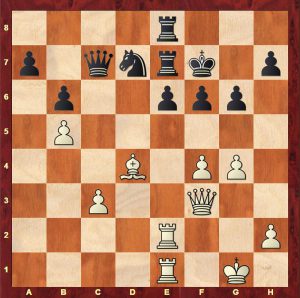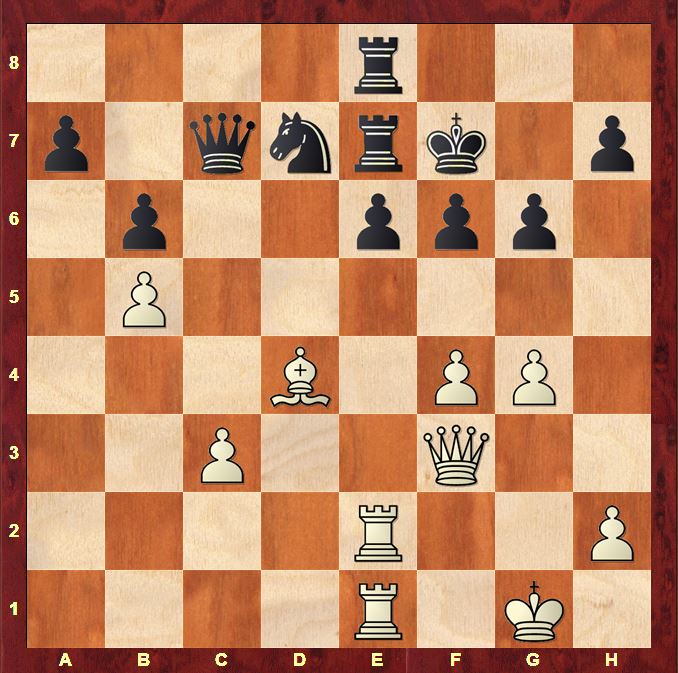One of the rewarding things about analysing the games of the old masters is that there is always plenty new to discover – not only in the games themselves but also in the annotations. That’s doubly true with Alekhine, strangely enough due to the excellence of Alekhine’s own annotations! Subsequent annotators have seemed intimidated by the depth of his notes and often limited themselves to quoting his variations uncritically. There are exceptions of course. The following attack was well annotated by Botvinnik, Kotov and John Nunn so most of the good stuff has already been written. However, a few nice variations still remained hidden, waiting to see the light of day!

In this position, Alekhine spotted a fabulous possibility that must have been an awful shock in Bogolyubov’s time-trouble!
Alekhine,Alexander – Bogoljubow,Efim
Nottingham 1936
35.g5 fxg5 36.f5
A stunning idea! Let’s take a look at the obvious stuff first:
1. 36…gxf5
leads to a type of sequence that is often easy to miss when short of time. White removes an obstacle with checks which then allows him to bring an additional piece into the game with check:
37.Qh5+ Kf8 38.Qh6+ Kg8 39.Qxg5+
Clearing the g-file
39…Kf8 40.Qh6+ Kg8 41.Rg2+
Winning
2. 36…exf5
is beautifully met by
37.Qd5+ Kf8 38.Bg7+
3. 36…Qf4 was played in the game. I tried for ages to make it work but couldn’t do any better than Bogolyubov!
37.fxe6+ Rxe6 38.Qd5 Nf6
I analysed this without looking at the rest of the game, and much to my shame I didn’t spot Alekhine’s very simple solution! My idea was much more complicated!
39.Bxf6 Qg4+ 40.Rg2 Qf5 41.Be5
41.Qa2 Kxf6 42.Rf1 was my win – I’d completely missed Alekhine’s line which is much stronger!
41…Kg8 42.Rf2 Qg4+ 43.Kh1 h5 44.Rg1 Qh4 45.Rf6 Kh7 46.Rxe6 Rxe6 47.Qd7+
1–0
However, Black has a much more crucial continuation:
4. 36…e5 blocking the line of the Bd4.
Alekhine had an interesting idea in mind to prosecute his attack… An exchange of queens!
a) 37.Qd5+
and now
37…Kf8 38.Qc6
Alekhine only considers the gorgeous line 38…Qxc6 39.bxc6 exd4 40.Rxe7 Rxe7 41.Rxe7 Kxe7 42.c7 winning
I feel duty bound to point out that after 42…d3, White must play 43.Kf1 – 43.c8(Q) d2 44.f6+ Kd6 is very embarrassing!
…but there is a much better defence:
38…Rc8 when 39.fxg6 (39.f6 Rf7 40.Qe6 Re8) Qxc6 is good for Black. White can play better a move earlier however:
38.fxg6 hxg6 (38…exd4 39.g7+ is a nice echo of the line after 36…exf5!)
39.Qc6 Qxc6 (39…Qd8 40.Qxg6 gives White good attacking chances)
40.bxc6 and now Black has to be very careful!
a) 40…Nb8 41.Bxe5 Kg8 42.Bd6 which does the trick!
42…Rxe2 43.Rxe2 Rxe2 44.c7
b) 40…Nc5 41.Bxe5 Kg8 42.c7 Na6 is the very accurate way to deal with White’s play 43.Ra1 Nxc7 44.Rxa7 Nd5 45.Rxe7 Rxe7 46.Kf1 when White should hold a draw.
There is however something even stronger for Black:
37…Kg7
Fearless!
38.Qc6 Rc8
Botvinnik’s 38…Qd8 is only good for a draw: 39.f6+ Nxf6 40.Bxe5 Rxe5 41.Rxe5 Rxe5 42.Rxe5 Qd1+ 43.Kg2 Qg4+ 44.Kh1 Qd1+
39.Rxe5 Nxe5 40.Rxe5
40…Qxc6 (40…Rxe5 41.Qxc7+) 41.Rxe7+ Kf8 wins for Black!
I spent a full 10 minutes checking this before I could believe it. All those tactics to exploit the opposition of the bishop on d4 and the king on g7 and none of them work! Not sure I would have found all this for Black with just a few minutes on my clock…
However, it looks as if 37.Qd5+ is a mistake. While I was working out these variations, Stockfish pointed out the best line at this stage which is
b) 37.fxg6+ Kxg6 38.h4 Kg7 39.Qc6 Rc8 40.Qg2 Qd6 41.Qxg5+ Qg6 42.Bxe5+ Rxe5 43.Rxe5 Nxe5 44.Rxe5 Qxg5+ 45.Rxg5+ which Stockfish felt would be enough for White to hold.
So 35.g5 fxg5 36.f5 was a great practical choice from Alekhine, but objectively it looks like Bogolyubov missed a chance of victory after 36…e5.



